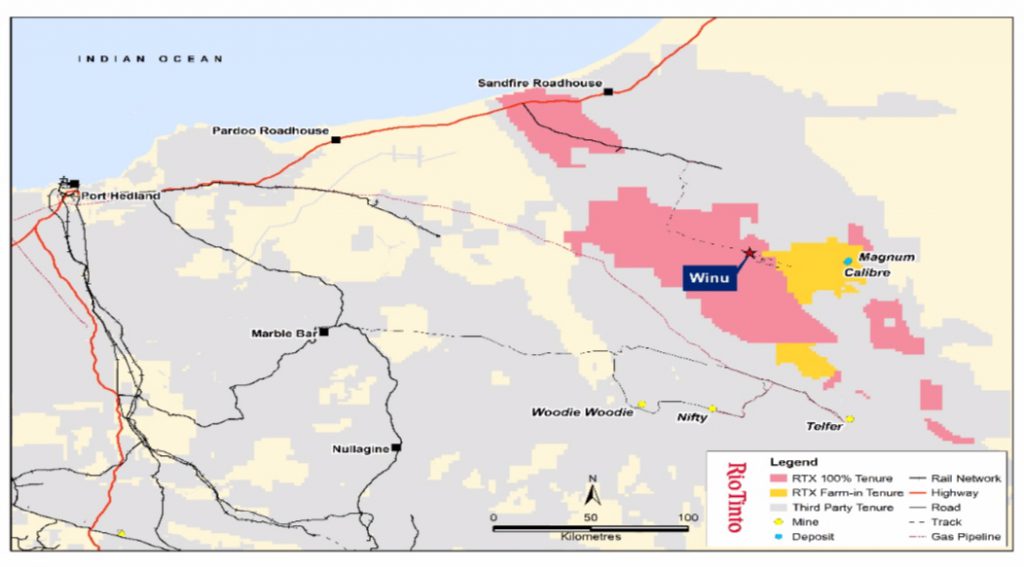A major new mineral province in the Pilbara region of Western Australia has been confirmed – and it is not iron ore or lithium.
Rio Tinto last night finally admitted that it has been working on a massive copper-gold-silver find in the Patterson area of the East Pilbara in Western Australia. There have been rumours of Rio’s discovery now for much of the past year.
Rio said last night it could not yet give a resource size for the find because more work was needed. But gold intersections range from 0.21 grams per tonne to 1.22 grams, copper grades ranging from 0.36% to 1.08% and silver grades from 0.42% to 4.34 grams to the tonne.
A more detailed analysis found grades of copper as high as 2.23% and 2.07%, gold grades of 5.4 grams to the tonne and silver grades as high as 26.4 grams and more than 17 grams over small six metre intersections.
“Assay results to date indicate relatively wide intersections of copper mineralisation associated with gold and silver. Vein style copper, gold and silver mineralisation beneath relatively shallow cover which ranges from 50 to 100 m.
The mineralisation remains open at depth and to the east, north, and south,” Rio said.
Intersections range from a few metres to three holes with intersections of more than 400 metres – the longest, 763 metres, another of 499 metres another more than 470 (on a down the hole basis) metres. The shallowness of the intersections opens up the possibility for a massive open cut operation.
Rio’s announcement came four months after the small UK listed miner, Greatland Gold announced what it called a “stunning” 275 metre intersection oft 4.77 grams a tonne (g/t) gold and 0.61% copper at its Havieron exploration licence.
The results from a single hole back up solid gold-copper mineralisation the company encountered during an exploration campaign at the prospect in May.
Greatland noted peak gold grades of 211.3g/t and peak copper of 8.45% in the recent drill intersection were about double those of previous hits.
While deep, at below 459 metres, the intersection provides further evidence that the Paterson could yield economic gold-copper resources outside those known at the existing Telfer and Nifty mines nearby.
The Rio Tinto discovery and the depth and size and grades of its intersections confirm that this is potentially a massive new mineral area.

Location map of the Winu project
Rio Tinto’s drilling is around 150km north-north-west of Telfer and last year news emerged that it had built a 50-person worker camp in the remote location and was building an airstrip to support its exploration campaign.
In a statement separate to its 2018 results released last night, the miner said it had: “discovered copper-gold mineralisation at the Winu project in the Yeneena Basin of the Paterson Province in Western Australia. The Winu project is located approximately 130 km north of the Telfer mine and 350 km southeast of Port Hedland.
The discovery was made by Rio Tinto Exploration (RTX) who are conducting a program targeted at finding copper mineralisation in the Paterson Province.
Rio said the exploration program consisted of eight reverse circulation (RC) and twenty diamond holes drilled between December 2017 and the end of last year, totalling 13,286 metres.
“Assays for all RC holes and fourteen diamond holes were received and validated at the time of preparing this release. Assays are pending for the remaining six diamond holes (partially or totally); partial results are included for two holes. Diamond drilling recommenced in mid-January 2019. Four holes have been completed and are pending assay results.
“Assay results to date indicate relatively wide intersections of copper mineralisation associated with gold and silver. Vein style copper, gold and silver mineralisation beneath relatively shallow cover which ranges from 50 to 100 m. The mineralisation remains open at depth and to the east, north and south.
“While results are encouraging, the exploration project is still at an early stage and drilling to date does not allow sufficient understanding of the mineralised body to assess the potential size or quality of the mineralisation nor to enable estimation of a Mineral Resource.
“The intercepted mineralisation is still open to the east, north, south and at depth and further drilling will continue during 2019,” Rio said in last night’s announcement.
This and several other prospects around the world will absorb much of the $US250 million Rio says it will be spending on exploration in 2019 with the company CEO JS Jacques saying “the bulk of it is in copper”.






